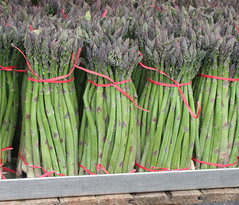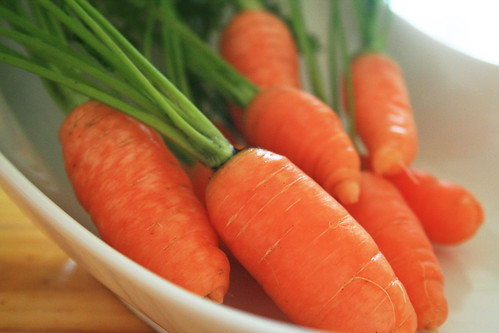I recently came across a great article at stumbleupon.com about storing fresh vegetables. Don’t you find that it’s a race to use all your vegetables before they go bad? I like to have a large variety in the house but unless I plan carefully it never fails that by the end of the week I’m tossing food in the garbage and that is such a crime! This is a handy and practical list to keep nearby and you can find a link here to an alphabetized list in PDF that you can put on your fridge. You can also go to this link if you would like to learn more about ethylene and how vegetables ripen.
Where to Store Fruits and Vegetables
There are basically three places you should store your fruits and vegetables – in the refrigerator, on the countertop, or in a cool dry place (not as cold as the fridge, but certainly not someplace “warm”). When in the fridge, there are three ways to store something – exposed, in a plastic bag, or in a paper bag. In general, the stuff that you put inside bags will want a more humid environment while the exposed ones do better in dryer climates. Ever notice water condensation inside a plastic bag? You can avoid that by putting a few holes in it. That water isn’t good for the produce, it promotes mold.
If all else fails, I generally try to store the fruit or vegetable the same way the grocery store does it. Asparagus is stored in a tray of water. Bananas hang out on the counter. It’s not a perfect system but if you aren’t sure how to store them, it doesn’t hurt to copy the grocery store.
Store in the Fridge
In general, you do not want to wash fruits and vegetables until right before you use them. If you do wash them, make sure to dry them before storing. Water promotes mold and mold is bad. There’s a subset on this list that you absolutely cannot wash, like berries, simply because you can’t get it dry enough!
Here are the items you will want to store in a fridge:
- Artichokes
- Beets
- Brussels sprouts
- Cabbage
- Cantelopes
- Celery
- Cherries
- Grapes
- Green beans
- Honeydew Melons
- Lima beans
- Leafy vegetables
- Leeks
- Mushrooms
- Okra
- Spinach
- Sprouts
- Summer squash
- Yellow squash
- Zucchini
Store After Ripening
Almost every one of these produce a lot of ethylene, so wait until they ripen before putting in the fridge:
- Avocados
- Nectarines
- Peaches
- Pears
- Plums
- Kiwi
Store in Water

Herbs and asparagus are best stored as you would flowers – snip off the ends and stand them upright in some water. If you’ve ever watched asparagus in the fridge, the cold dry air sucks the moisture out of each stem. The stem will shrivel, wrinkle, and if you try to cook and eat it, it’s like eating a stem. If you want to keep it fresh, store them as you would display flowers – trim the end and stand it up in a shallow cup of water.
Store in Paper Bag
Mushrooms and okra are best stored inside a paper bag, because a paper bag prevents light.
Do Not Wash, Store in Plastic Bag

Definitely don’t wash these until right before you use them. When you store them, keep them in the plastic bag:
- Broccoli
- Carrots
- Cauliflower
- Chard
- Corn
- Cranberries
- Green onions
- Lettuce
- Peas
- Radishes
Do Not Wash, Store in Single Layer
Don’t wash these before you put them in a fridge and, if you can, store in a single layer. If you wash them, the skins will get soggy and it’ll accelerate spoilage. The argument for storing them in a single layer is because when they do start to go bad, the juice that leaks out can accelerate the decline of other berries. Storing in a single layer reduces the amount of damage while permitting air flow.
- Blackberries
- Blueberries
- Raspberries
- Strawberries
Store on the Countertop
- Apples
- Bananas
- Tomatoes
- Basil
- Cucumbers
- Eggplant
- Ginger
- Grapefruit
- Jicama
- Lemons
- Limes
- Mangoes
- Oranges
- Papayas
- Peppers
- Persimmons
- Pineapple
- Plantains
- Pomegranates
- Watermelon
Store in Cool, Dry Dark Place
Many root vegetables are best stored in a cool dry dark place, which is why root cellars were so popular back in the days of yore. One thing to keep in mind is that air circulation is important because of ethylene buildup. You may have heard the advice that you shouldn’t store onions and potatoes, that’s because of ethylene.
- Acorn squash
- Butternut squash
- Garlic
- Onions
- Potatoes
- Pumpkins
- Shallots
- Spaghetti squash
- Sweet potatoes
- Winter squash
Master Alphabetized List in PDF










6 Comments
David and Lorian Lawes
August 8, 2013 at 1:48 pmGood Information! We were pleasantly surprised to see we actually do most of this right!
Robyn
August 8, 2013 at 3:37 pmHey you two! Glad you enjoyed the article. Will call this week to catch up on the family reunion news!
xoxo
Mindy Whipple
August 8, 2013 at 9:10 pmI tell you, you must have read my mind with this post! I picked two lovely cucumbers and we ate one and I put the other one in the refrigerator overnight where it promptly started wilting…so sad. I thought, I need to see if there is a tip list online so I don’t store my produce wrong. (I try to copy the grocery store too.) THANK YOU for the great info Robyn. I just printed one for me, one for my daughter and one for my parents. Yay!!
Stacy Curran
August 9, 2013 at 8:39 amI have never taken the time to learn this,a nd ALL of my produce goes bad. It such a shame and i feel so guilty every week. Here is ANOTHER of your posts that I will be referring back to. Thank you!
Stacy
designchic
August 9, 2013 at 9:26 pmThis is great info and I’ve saved for future reference – so hate when I have to throw away fruits and veggies! Have a great weekend ~
Summer Garden Vegetable Soup | The NY Melrose Family
June 15, 2015 at 5:00 am[…] exactly how to store your produce so that you can get the longest life from them, I’ve got a great article on my blog that will give you a print out chart that you can post in your kitchen for handy […]